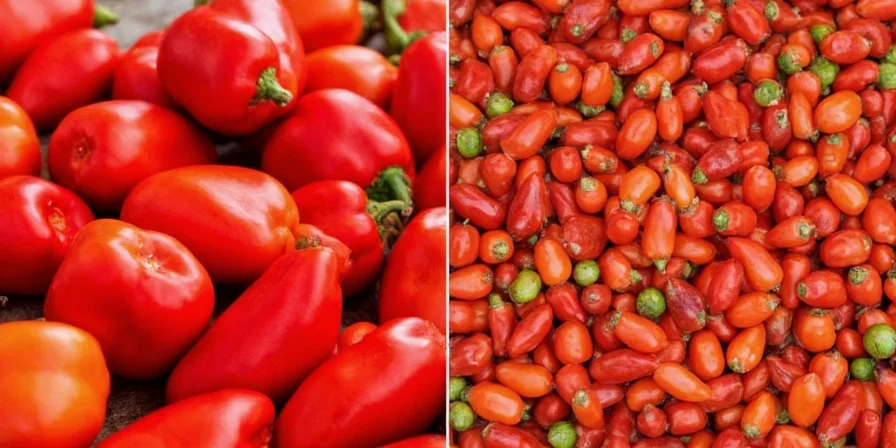
Table of Contents
- Quick Answer: Key Differences
- Basic Differences Every Cook Needs to Know
- Hungarian Paprika: When to Use It
- Spanish Paprika: When to Use It
- Side-by-Side Comparison
- Substitution Guide (What Actually Works)
- How to Store for Maximum Freshness
- Which Should You Buy?

Quick Answer: Hungarian vs Spanish Paprika
Use Hungarian paprika for authentic Hungarian dishes like goulash where sweet pepper flavor matters most. Use Spanish paprika (especially smoked) for Spanish dishes like chorizo where smoky depth is essential. They're not interchangeable—Hungarian is sweet and bright red while Spanish is smoky and deeper red. Swapping them changes your dish's fundamental character.
Basic Differences Every Cook Needs to Know
Most home cooks think paprika is paprika, but the difference between Hungarian and Spanish varieties affects your dishes more than you realize. Here's what matters for actual cooking:
- Hungarian paprika is made from sweet, non-smoked peppers and delivers pure pepper flavor with natural sweetness
- Spanish paprika (especially Pimentón de La Vera) is smoked over oak, giving it a distinct campfire-like aroma
- You'll ruin traditional Hungarian goulash with Spanish smoked paprika (too smoky)
- You'll miss the authentic flavor in Spanish patatas bravas with Hungarian paprika (no smoke)
Forget the biochemistry—what matters is how these differences impact your cooking results. Let's break down exactly when to use each.

Hungarian Paprika: When to Use It
Hungarian paprika shines in dishes where the pure flavor of sweet peppers matters most. It's the backbone of traditional Hungarian cuisine:
- Essential for authentic goulash and halászlé (fisherman's soup)
- Best added in the last 10 minutes of cooking (heat degrades its flavor)
- Ideal for dishes with carrots, onions, or tomatoes that enhance its natural sweetness
- Comes in varieties from mild (Különleges) to hot (Erős)—choose based on recipe
Pro tip: For best results, bloom Hungarian paprika in oil below 175°F (79°C) for 90 seconds before adding other ingredients. This releases flavor without bitterness.

Spanish Paprika: When to Use It
Spanish paprika, especially the smoked varieties from La Vera, brings a distinctive smoky dimension that transforms dishes:
- Dulce (sweet) is perfect for traditional patatas bravas and paella
- Picante (spicy) gives authentic heat to chorizo and blood sausages
- Can be added during cooking (its smoke compounds are heat-stable up to 220°F/104°C)
- Works best with fatty ingredients like olive oil or pork that absorb smoke flavors
Pro tip: For maximum smoke flavor, add Spanish paprika during the vegetable sautéing phase before adding liquids to your dish.

Side-by-Side Comparison
Here's exactly how Hungarian and Spanish paprika differ for practical cooking purposes:
| Characteristic | Hungarian Paprika | Spanish Paprika |
|---|---|---|
| Best For | Hungarian goulash, chicken paprikash | Chorizo, patatas bravas, paella |
| Flavor Profile | Sweet pepper, mild earthiness | Smoky, sometimes slightly bitter |
| Color | Bright cadmium red | Deep brick red |
| When to Add | Last 10 minutes of cooking | During sautéing phase |
| Heat Tolerance | Loses flavor above 175°F (79°C) | Stable up to 220°F (104°C) |

Substitution Guide (What Actually Works)
Need to substitute one for the other? Here's what works and what doesn't:
When Hungarian is Called For (and You Only Have Spanish)
- Emergency substitution: Use 1 tsp sweet Spanish paprika + ¼ tsp sweet paprika + ⅛ tsp cayenne
- Avoid: Using smoked Spanish paprika (it will make your goulash taste like campfire)
- Better option: Buy Hungarian paprika online—it's worth it for authentic results
When Spanish is Called For (and You Only Have Hungarian)
- Best substitution: 1 tsp Hungarian paprika + ¼ tsp chipotle powder (for smoke)
- Acceptable alternative: 1 tsp Hungarian paprika + tiny pinch of liquid smoke
- Warning: Without smoke element, your Spanish dishes will lack authenticity

How to Store for Maximum Freshness
Paprika loses potency faster than most spices. Follow these practical storage tips:
- Store in amber glass (blocks UV light that degrades flavor)
- Keep in a cool, dark place away from stove (heat speeds degradation)
- Include silica packet to control moisture (prevents clumping)
- Use within 6 months for best flavor (even when stored properly)
- Freshness test: Sprinkle in warm oil—if it doesn't immediately turn vibrant red and release aroma, it's past prime
Which Should You Buy? (Simple Decision Guide)
Keep both in your pantry, but use them correctly:
- Buy Hungarian paprika when: Making Hungarian dishes, when recipe specifies "sweet paprika", or when you want pure pepper flavor without smoke
- Buy Spanish paprika when: Making Spanish dishes, when recipe specifies "smoked paprika" or "pimentón", or when you want smoky depth
For most home cooks, having both a Hungarian sweet paprika and Spanish smoked paprika covers 95% of needs. This small investment transforms dish authenticity more than any other spice upgrade you can make.

Frequently Asked Questions
Can I substitute Hungarian paprika in Spanish recipes?
Only in emergencies. Hungarian lacks smoked phenolic compounds essential for Spanish dishes. For paella, use 1 tsp Spanish smoked paprika + 1/4 tsp chipotle powder as closest approximation.
Why does my paprika-based sauce turn bitter?
Bitterness occurs when Hungarian paprika exceeds 175°F (79°C). Always add during final cooking stages. Spanish paprika rarely causes bitterness due to heat-stable compounds.
How can I test paprika freshness?
Place 1/4 tsp in warm oil. Fresh paprika releases immediate aroma and turns oil vibrant red within 15 seconds. Dull color or delayed reaction indicates degradation.
Does paprika have health benefits?
Both contain capsaicinoids with antioxidant properties. Hungarian paprika has higher vitamin C content (60% DV per tbsp), while Spanish smoked offers unique phenolic antioxidants from the smoking process.
What's the difference between 'Pimentón de La Vera' and regular Spanish paprika?
Only paprika produced in Spain's La Vera region using traditional oak smoking can be labeled 'Pimentón de La Vera'. This Denomination of Origin certification guarantees specific terroir and processing methods.











 浙公网安备
33010002000092号
浙公网安备
33010002000092号 浙B2-20120091-4
浙B2-20120091-4